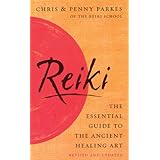
Average Reviews:

(More customer reviews)The information in this book is absolutely fantastic. It has 14 chapters which cover: 1) What is Reiki?, 2) The History of the Usui System of Reiki, 3) How Reiki differs from other healing methods, 4) Reiki for personal healing, 5) Reiki Treatments, 6) Combining Reiki with other methods of healing, 7) Other ways of using Reiki, 8) Reiki with chronic illness, 9) Reiki for self-development and spiritual growth, 10) The First Degree class, 11) The Second Degree class, 12) The Third Degree or Master's Training, 13) How to find a Reiki Master 14) Becoming a Reiki Practitioner.
My favorite parts of this book is the best quality and largest photo of Dr. Usui which gives true meaning to the saying "A picture is worth a thousand words." The section about when not to use Reiki (don't give after a pre-operative anaesthetic has been administered or during an operation. And much more info I'll need to know as a nurse.) Also, I learned "If a person is suffering from a particularly severe complaint, it might be wiser to avoid the problem area completely for the time being, allowing the energy to flow through from the other areas and reabalance the system in that way." Unfortunately I learned this after the fact of touching the upper arm of my pastor who had rotator cuff surgery. I had to stop because he was so tense me getting anywhere near his shoulder. Also I should have asked first if I could do Reiki which I also learned in this book. There is just a world of information inside! My very favorite part I will write out as it is only a paragraph on page 72 but I've used it and it is so powerful I can hardly believe it!
"Using Reiki to Balance the Chakras: Sitting in a chair, place one hand on the forehead and one on the back of the neck. Then place both hands on the shoulders. After this, place one hand on the chest and one on the back. Next, place one hand on the solar plexus and one hand on the corresponding position on the back. Finally place one hand on the abdomen and one hand on the tailbone. This short treatment will balance the chakras effectively."
Note: I did this exercise [above] as a first level healer and it worked just as strong as where I am now at second level! It really works! Try it after having/viewing an attunement. A good attunement dvd I recommend is the Reiki: First level attunement by Steve Murray offered here at Amazon. o8E
Soar!
Click Here to see more reviews about: Reiki: The Essential Guide to the Ancient Healing Art
Reiki is a Japanese word meaning Universal Life Force Energy. Drawing on ancient practices, Reiki balances the energy in the body, renewing vitality and bringing about a powerful feeling of serenity and relaxation through the laying on of hands. Reiki can be used to relieve the problems associated with stress, tension, chronic illness and post-operative pain. In this revised and updated edition, Chris and Penny Parkes explain what to expect from a treatment, how it works and how it can be of benefit—and even show how you too can train to practice Reiki.
Click here for more information about Reiki: The Essential Guide to the Ancient Healing Art








